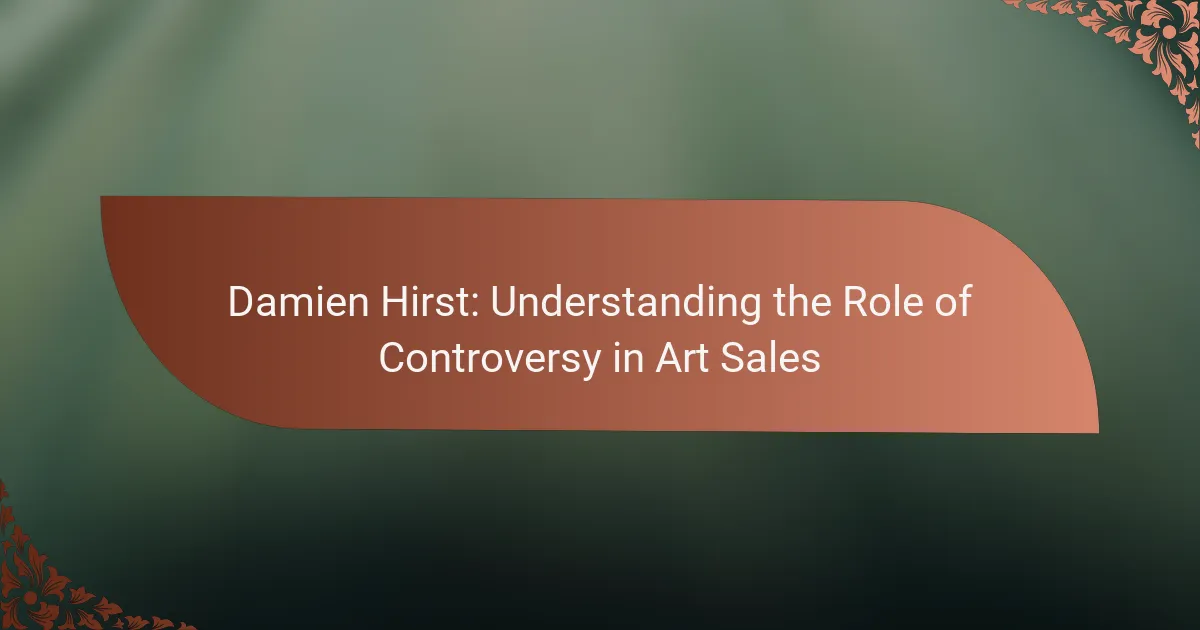Controversy is a powerful tool in the art market, significantly impacting sales and collector interest. Damien Hirst’s provocative works challenge societal norms and provoke discussions on themes like death and consumerism. His unique ability to blend shock value with commercial success sets him apart in contemporary art. This article explores how Hirst’s approach to controversy enhances visibility, drives auction prices, and influences contemporary culture.
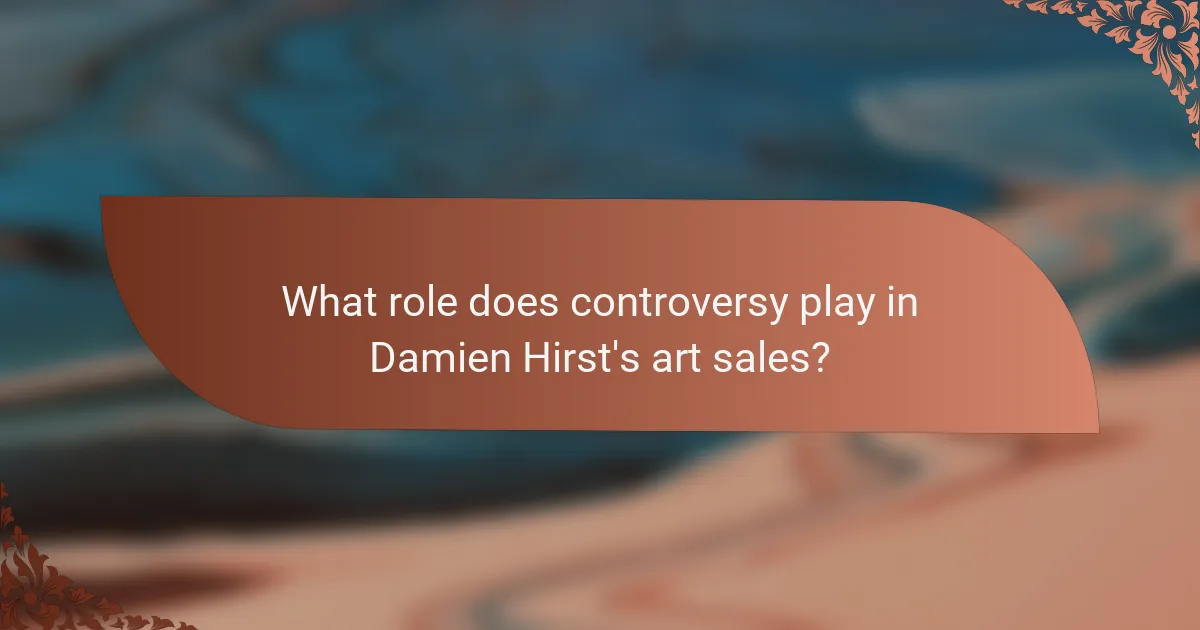
What role does controversy play in Damien Hirst’s art sales?
Controversy plays a significant role in Damien Hirst’s art sales by driving public interest and increasing perceived value. His provocative works often challenge societal norms, attracting media attention and collectors. This heightened visibility can lead to higher auction prices and demand. Hirst’s unique approach to themes like death and consumerism further distinguishes his art, making it a focal point in discussions about contemporary art. As a result, controversy not only enhances his brand but also solidifies his position in the art market.
How has Hirst’s use of controversy shaped public perception?
Damien Hirst’s use of controversy has significantly influenced public perception, often enhancing the desirability of his artworks. His provocative themes and unconventional methods challenge traditional art norms, attracting media attention and public discourse. This controversy has elevated his brand, making his pieces highly sought after in the art market. As a result, Hirst’s ability to provoke thought and debate has transformed him into a central figure in contemporary art, impacting both sales and critical reception.
What are the key controversies surrounding Hirst’s work?
Damien Hirst’s work is often controversial due to its provocative themes, use of unconventional materials, and commercialization of art. Critics argue that his pieces prioritize shock value over artistic integrity. Unique attributes include the use of dead animals and pharmaceutical imagery, which challenge societal norms. Rare attributes involve the high prices his works command at auctions, raising questions about the art market’s values. These controversies fuel discussions about the nature of art and its role in society.
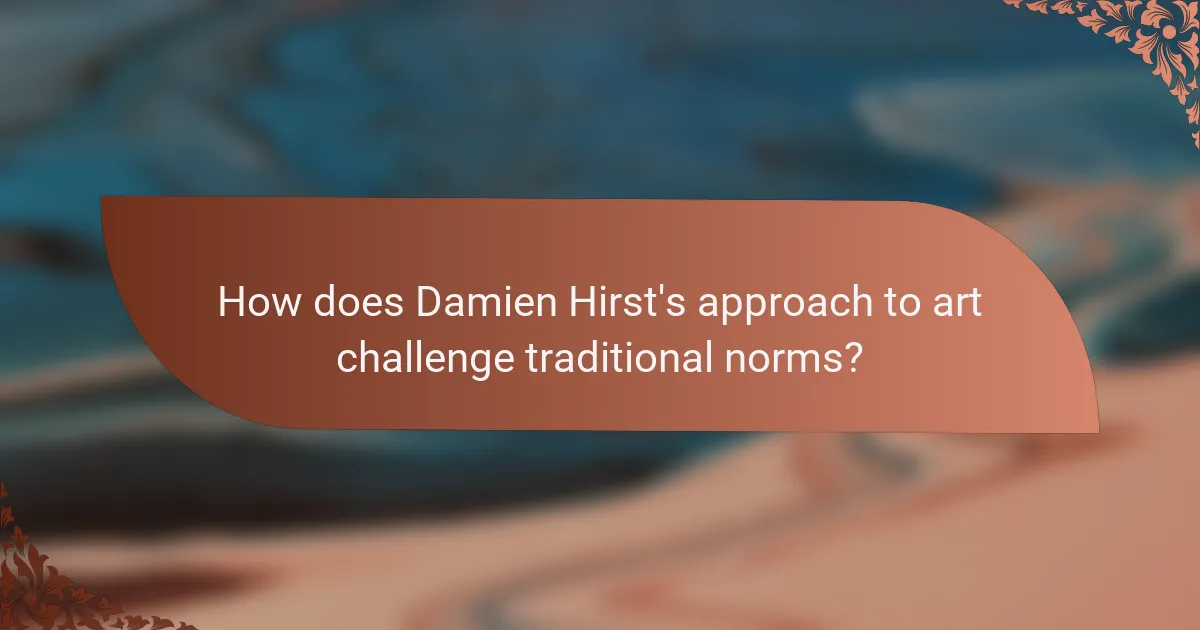
How does Damien Hirst’s approach to art challenge traditional norms?
Damien Hirst’s approach to art challenges traditional norms by embracing controversy as a key element in art sales. His use of unconventional materials and themes provokes strong reactions, redefining the boundaries of artistic expression. For instance, his iconic works often feature dead animals, which confront viewers with ethical dilemmas about art and life. This strategy not only attracts attention but also drives up market demand, as collectors seek pieces that spark dialogue. Hirst’s unique ability to blend shock value with commercial success exemplifies a new paradigm in the art world, where controversy can be a lucrative asset.
Which aspects of Hirst’s art evoke strong reactions?
Damien Hirst’s art evokes strong reactions through its provocative themes, shocking imagery, and exploration of mortality. His use of unconventional materials, such as preserved animals, challenges viewers’ perceptions of life and death. The unique attribute of Hirst’s work lies in its ability to blend beauty with discomfort, prompting intense emotional responses. Additionally, the rarity of his pieces, often produced in limited editions, adds to their allure and controversy in the art market.
How does Hirst’s work reflect societal issues?
Hirst’s work critiques societal values, reflecting themes of mortality and consumerism. His provocative pieces challenge perceptions of art and its commercialization. For instance, “The Physical Impossibility of Death in the Mind of Someone Living” confronts viewers with the reality of death, prompting discussions on life and materialism. This engagement with complex issues demonstrates how art can serve as a mirror to society’s concerns.
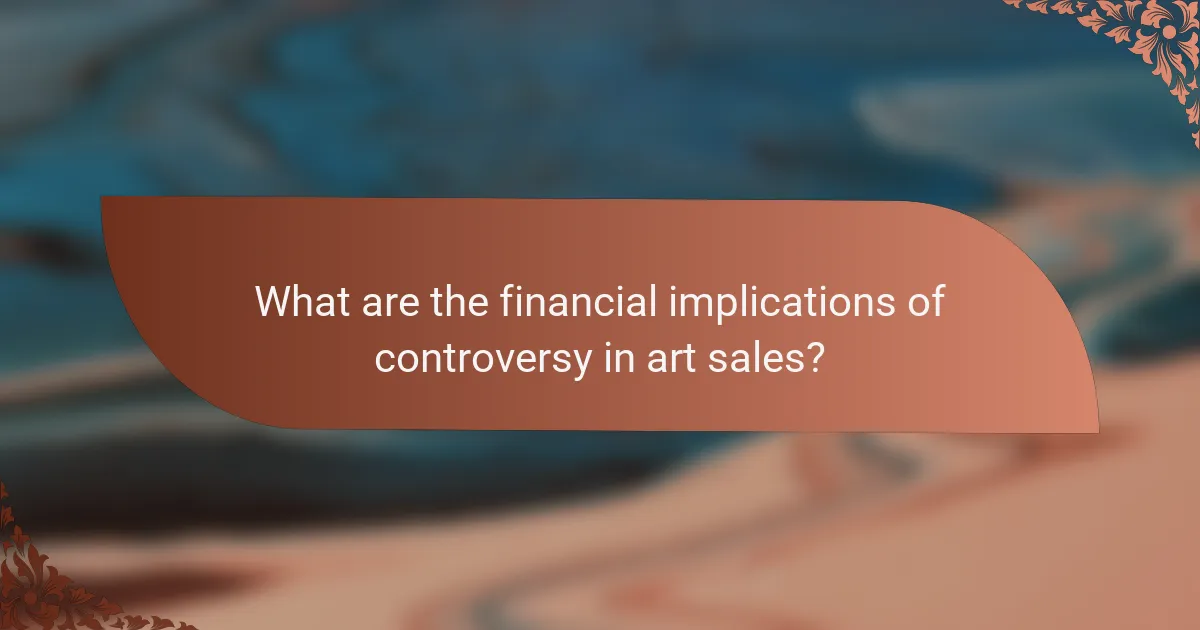
What are the financial implications of controversy in art sales?
Controversy in art sales can significantly impact financial outcomes. Damien Hirst’s provocative works often drive prices higher due to heightened public interest and media coverage.
Controversial pieces can attract collectors seeking unique investments, leading to inflated auction prices. For instance, Hirst’s “The Physical Impossibility of Death in the Mind of Someone Living” sold for $8 million, illustrating how controversy can enhance perceived value.
Additionally, controversies can lead to volatility in art markets. While some investors thrive on the hype, others may face risks if public sentiment shifts. Hirst’s approach exemplifies how navigating controversy can be both lucrative and precarious in the art world.
How does controversy affect the value of Hirst’s artworks?
Controversy can significantly enhance the value of Damien Hirst’s artworks. His provocative themes and unconventional methods generate public discourse, which often leads to increased demand and higher prices. For instance, Hirst’s use of dead animals in formaldehyde sparked debates about ethics in art, attracting both criticism and admiration. This duality often results in a unique market position, where artworks become coveted collectibles. As a result, Hirst’s pieces frequently appreciate in value, reflecting the complex relationship between controversy and art sales.
What trends can be observed in the art market related to controversial artists?
Controversial artists like Damien Hirst significantly influence art market trends. Their provocative works often attract media attention and drive higher sales. Hirst’s unique approach to art challenges traditional norms, creating a distinct market niche. As a result, controversy can enhance both perceived value and demand for artworks.
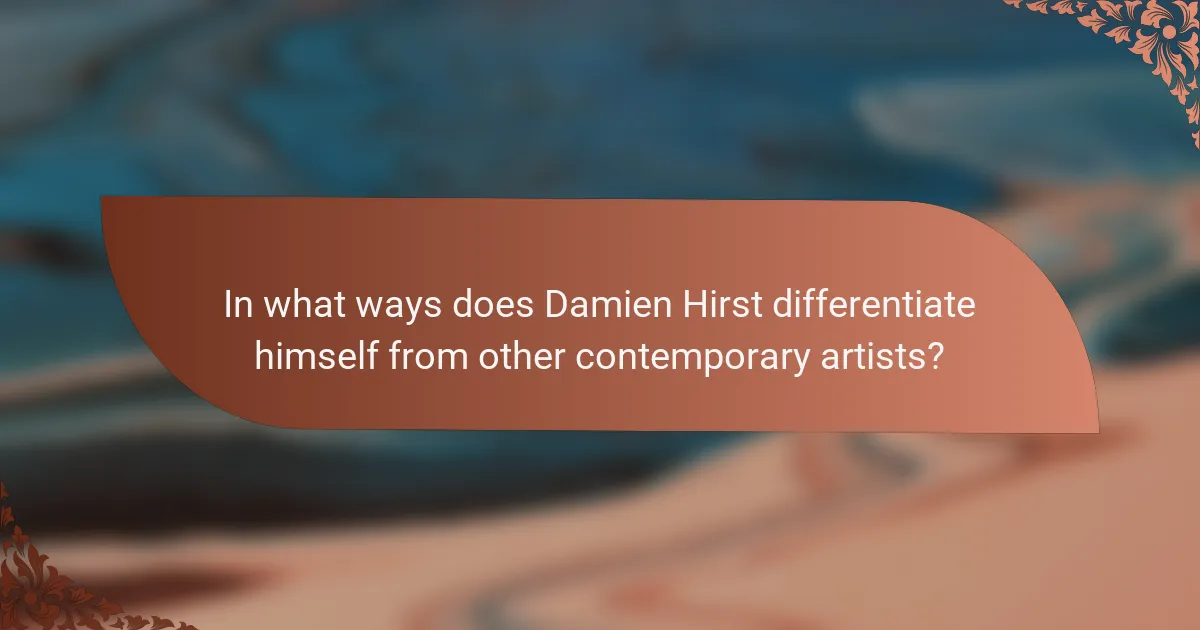
In what ways does Damien Hirst differentiate himself from other contemporary artists?
Damien Hirst differentiates himself from other contemporary artists through his provocative use of controversy. His works often challenge societal norms, creating dialogues around themes like life, death, and consumerism. Hirst’s unique attribute is his ability to blend art with commercial success, exemplified by his record-breaking auction sales. This approach has established him as a leading figure in the art world, leveraging shock value to engage audiences and boost sales. Rarely do artists achieve such a seamless fusion of art and marketability, setting Hirst apart in contemporary art.
What unique techniques does Hirst employ in his artwork?
Damien Hirst employs unique techniques such as the use of unconventional materials, including formaldehyde and animal specimens, to challenge perceptions of mortality and art. His spot paintings and butterfly artworks showcase a blend of scientific precision and aesthetic appeal. Hirst’s provocative themes often elicit strong emotional responses, enhancing the value of his pieces in the art market. Additionally, his strategic collaborations and marketing tactics amplify the controversy surrounding his work, making it a focal point in contemporary discussions on art and commerce.
How does Hirst’s branding influence his art sales?
Hirst’s branding significantly boosts his art sales through controversy and marketing strategies. His provocative themes attract media attention, enhancing visibility and desirability. Limited editions and auction strategies create scarcity, driving up prices. Additionally, collaborations with luxury brands elevate his status, appealing to collectors seeking exclusivity.
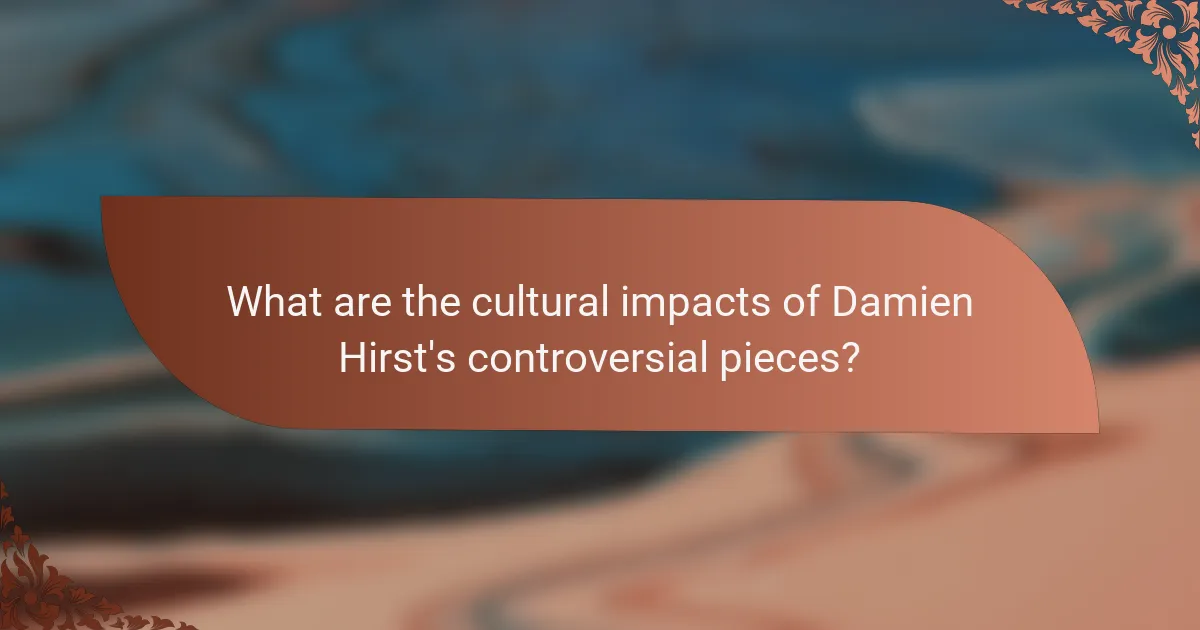
What are the cultural impacts of Damien Hirst’s controversial pieces?
Damien Hirst’s controversial pieces have significantly influenced contemporary culture by challenging perceptions of art and commerce. His work often provokes debate, pushing boundaries and questioning moral and ethical values. This has led to increased visibility for modern art, attracting diverse audiences and sparking critical discussions about the role of the artist. Hirst’s unique approach to art as a commodity has redefined market dynamics, emphasizing that controversy can drive sales and elevate an artist’s profile. As a result, Hirst’s influence extends beyond galleries, impacting popular culture and consumer behavior.
How do different audiences respond to Hirst’s work across various regions?
Different audiences respond to Damien Hirst’s work in varied ways based on cultural, social, and economic factors. In regions with strong contemporary art markets, his controversial pieces often generate significant interest and sales. In contrast, audiences in more conservative areas may react negatively, viewing his work as provocative or offensive. For example, in Europe, Hirst’s use of unconventional materials is often celebrated, while in parts of Asia, traditional values may clash with his artistic choices. Understanding these regional differences is crucial for art dealers and collectors.
What role does media coverage play in shaping Hirst’s reputation?
Media coverage significantly influences Damien Hirst’s reputation by amplifying public perception and engagement. Positive or negative press can enhance or detract from his market value. For example, controversial exhibitions often lead to heightened visibility, creating a buzz that drives sales. As a result, media portrayal becomes a critical factor in shaping the art market dynamics surrounding Hirst’s work.
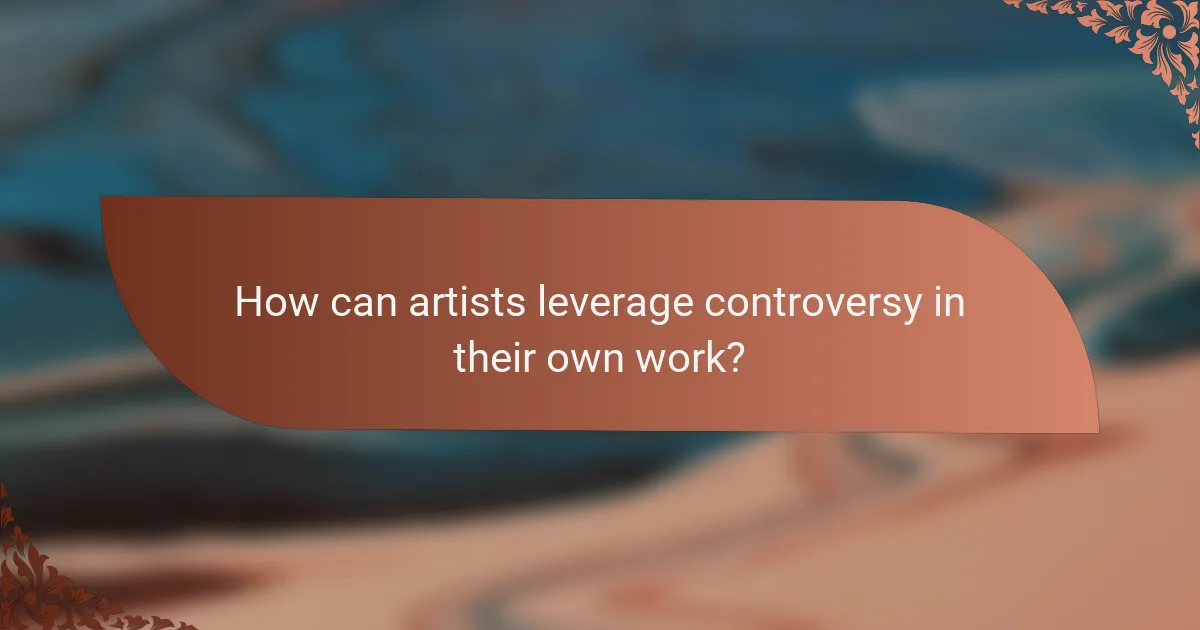
How can artists leverage controversy in their own work?
Artists can leverage controversy to enhance their visibility and increase art sales. Damien Hirst exemplifies this strategy through provocative works that challenge societal norms. His use of unconventional materials and themes generates public discourse, attracting media attention and potential buyers. By embracing controversy, artists can create a unique identity that distinguishes their work in a crowded market, ultimately driving demand and sales.
What strategies can emerging artists adopt from Hirst’s approach?
Emerging artists can adopt strategies from Hirst’s approach by leveraging controversy to capture attention. They should create provocative works that challenge norms, fostering public discourse. Engaging with social media can amplify their message and reach wider audiences. Collaborating with unexpected partners can also enhance visibility and create buzz. Lastly, understanding the market dynamics and pricing strategies can help in positioning their art effectively.
What common pitfalls should artists avoid when using controversy?
Artists should avoid using controversy solely for attention, as it can backfire. Focusing on authenticity and meaningful engagement is crucial. Misjudging audience reactions can alienate potential buyers. Overexposure can diminish the impact of the work. Additionally, failing to connect the controversy to the art’s message may lead to confusion about the artist’s intent.
What best practices can maximize the impact of controversial art?
To maximize the impact of controversial art, focus on strategic marketing, audience engagement, and narrative framing. Highlight the unique attributes that provoke thought and discussion. Utilize social media to create buzz and foster community dialogue around the artwork. Collaborate with influencers to broaden reach and appeal. Finally, ensure that the exhibition experience is immersive, allowing viewers to connect emotionally with the art.
